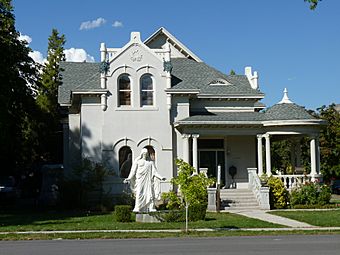John R. Twelves House facts for kids
Quick facts for kids |
|
|
John R. Twelves House
|
|
 |
|
| Location | 287 East 100 North, Provo, Utah |
|---|---|
| Area | less than one acre |
| Built | 1906 |
| Architect | John R. Twelves |
| Architectural style | Romanesque, Victorian Eclectic |
| MPS | Entreprenurial Residences of Turn-of-the-Century Provo TR |
| NRHP reference No. | 82004181 |
| Added to NRHP | July 23, 1982 |
The John R. Twelves House is a historic home in Provo, Utah. It was built in 1906. This house is special because it's listed on the National Register of Historic Places. This means it's an important part of history.
Contents
The John R. Twelves House: A Historic Home
This house is located at 287 East 100 North in Provo. John R. Twelves built it in 1906. He was an important person in Utah's history. He was involved in a big mining company. He also worked as the treasurer and recorder for Utah County. The city of Provo recognized the house as a historic landmark in 1996.
From 1911, the house became the home of George H. Brimhall. He was the president of Brigham Young University at that time.
Since 2005, the Twelves House has been used by Main Street Movie Company. This company makes and shares movies. A large marble statue of Jesus is on the front lawn. It was a prop for a movie called Falling.
Provo's Grand Victorian Mansions
Between 1893 and 1908, many large Victorian homes were built in Provo, Utah. These homes show how wealthy and unique Utah's most successful business owners were. These grand houses include the Charles E. Loose House, the William H. Ray House, the Knight-Allen House, the John R. Twelves House, the Jesse Knight House, the Knight-Mangum House, and the Thomas N. Taylor House.
These homes were built during a time called the "Gilded Age." They show the wealth and style of their owners. They are larger and more detailed than most houses in Provo. Many different styles were used, often combined in one house. These styles included Eastlake, Italianate, and Romanesque. Most of these houses are made of brick. They also feature beautiful stained glass windows.
Jesse Knight and Utah's Mining History
Mining for valuable metals changed Utah's economy a lot. It helped Utah become more industrial. The Tintic Mining District was a key area for this. It was founded in 1869. By 1899, it was Utah's top mining center.
Jesse Knight was a very important person in the Tintic mining success. He and his family lived in Provo. Jesse Knight became rich from his Humbug mine in the mid-1890s. This allowed him to open more mines.
Knight also created the Knight Investment Company. This company included many different businesses. These included mining companies, a woolen mill, a ranching company, and a bank in Provo. John R. Twelves also became very rich from the mining business. He was a leader in the Grand Central Mining Company. As the company's stock grew, so did his wealth. By 1902, Twelves had enough money to build his beautiful home.
Protecting History
The John R. Twelves House was added to the National Register of Historic Places in 1982. This means it is officially recognized as an important historic building. It was part of a group of six Provo houses listed at the same time. These houses are protected so future generations can learn from them.



